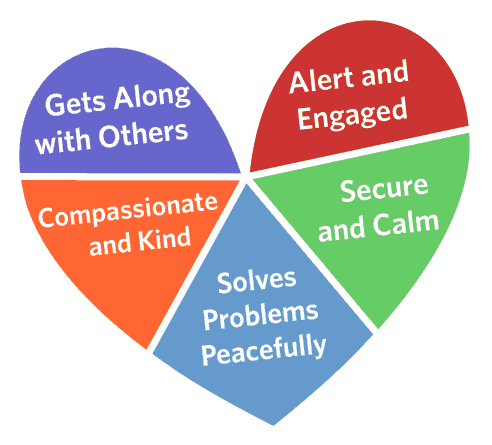
Educating children's hearts doesn't need to be complicated! The 5 Heart-Mind qualities - which are the foundation of Heart-Mind well-being - are simply a part of daily life, for children and adults alike.
When things are going well and we feel good, we may hardly notice that we are practicing the 5 Heart-Mind qualities.
It's when the going gets tough and we feel less than our best that we may notice that one or more areas of Heart-Mind well-being are lacking in our lives - which may show up as relationship difficulties, out of control emotions, underachieving, or stress. This is just as true for children as it is for adults.
Fortunately, challenging times present an opportunity to connect deeply with the children we care for, and learn together about how to make our hearts and minds stronger and more resilient.
This resource describes the 5 Heart-Mind qualities in simple, child-friendly language. For each quality, it suggests an activity you can do together to strengthen that part of your hearts.
How to use this resource to learn about the 5 Heart-Mind Qualities with a child today:
- Read the descriptions aloud and invite your child to act out each quality (eg. show the emotions associated with it on their face and through their body, or act out different scenarios where that quality is absent vs. present)
- Select only one or a few of the qualities that a child (or adult!) is currently struggling with, and read about them together and have a discussion
- Read a favourite book together and identify when the characters are practicing different Heart-Mind qualities
- Write a story together in which characters use Heart-Mind qualities to overcome challenges or solve a problem
- Draw a picture of each Heart-Mind quality and put them up on the wall or fridge as a visual reminder, or bind them together as a picture book (the adult can help with captions, if needed)
- Use the descriptions in this resource to help you make Heart-Mind Valentines (this beautiful, crafty activity can be done all year long!)
- Learn about the 5 Heart-Mind Qualities through Sophie's Heart - an interactive story for children that teaches Heart-Mind well-being
A Child-Friendly Introduction to the 5 Heart-Mind Qualities
Secure and Calm:
- When we feel secure, we are pretty sure that bad things won’t happen to us. We feel calm when our bodies and minds are relaxed.
- We most often feel secure and calm when we know that we can count on the people in our lives to help us when we need it, to care about how we are feeling, and to love us always[1]. These people can be family, like our parents, siblings, or grandparents, close friends, or even teachers, coaches or neighbors. What’s important is that we feel safe when we are with them because we know they are looking out for us. Because we feel safe when we are with them, we are able to feel secure and calm when we are apart, too!
- Being in places that are quiet, comfortable, and familiar can also help us feel secure and calm.
- Activity: Secure and Calm: Sharing a Book
 Compassionate and Kind:
Compassionate and Kind:
- We are compassionate when we feel for others who are suffering and want to help them. We are kind when we are friendly, giving, and thoughtful towards others.
- Suffering means feeling bad or having a hard time. Someone who is suffering might feel sad or afraid, have pain in his body or heart, or experience hard things like being sick or poor.
- We most often feel compassionate and kind when we notice how we feel when we see other people suffering[2], and use that feeling to do something nice for them – that is compassion. We can be compassionate towards ourselves too! We feel kind when we do nice things for others even when they are not suffering. We can also be kind towards ourselves!
- Activity: Lesson Plan: Teaching Kindness with Chrysanthemum
Alert and Engaged:
- We are alert when we notice what is going on here and now, in the present moment. We are engaged when we can direct our attention, feelings, and actions in the way we would like to[3].
- We most often feel alert and engaged when we respond to our feelings, wants, and needs wisely. This might mean waiting for something we want, staying on the soccer field (instead of marching off) when we miss a chance to score, or sharing with a friend even when an adult isn’t watching. To be able to do these things, we need to be able to understand how what we do now will affect others and ourselves later on. This is why being in the present moment is an important part of being alert and engaged.
- Activity: Alert and Engaged: Modelling with Puppets
Gets Along with Others:
- We are able to get along with others when we take care of our own feelings and play with others in a way that recognizes they have feelings too.
- We most often feel able to get along with others when we know how to name what we are feeling and how to take care of it when it gets big and overwhelming. This might mean taking deep breaths when we feel angry, or taking some quiet time alone when we feel anxious.
- We also feel able to get along with others when we do things like take turns, share, or talk about a problem with a friend instead of pushing or shoving them[4]. Doing these things honors the fact that our friends have feelings too.
- Activity: What Colour is Your Heart?
Solves Problems Peacefully:
- We are able to solve problems peacefully when we create solutions that are fair and don’t hurt others or ourselves.[5]
- We most often feel able to solve problems peacefully when we can see other peoples’ points of view, even when they are different from our own. We are also able to solve problems peacefully when we understand how our words and actions make other people feel. When we do both of these things, we are more likely to come up with solutions that are fair and don’t hurt anyone.
- Activity: Lesson Plan: Skits to Solve School Problems in Peaceful Ways
Thumbnail image credit
To DO:
link to connect and redirect (siegel)
link to resillience
link at least 1 or 2 papers for each quality citing evidence in SEL or other terms (eg. from heart mind guide 2014 or other sources)
Feeling secure is grounded in attachment. Attachment refers to a close bond between two people, especially the bond between a child and caregiver. Children are able to thrive when they have a secure attachment with their caregiver(s). Secure attachment forms when caregivers consistently respond to the childs needs and are attuned to the child over a long period of time. Because of this high level of trust, children are able to express and learn about their emotions in secure attachment relationships, which helps them feel calm.
We foster secure attachment when we strengthen the Secure & Calm parts of our hearts.
Body, mind, and emotions are involved in feeling compassion.
When we see someone in pain, the anterior cingulate and amygdala fire in the brain, causing us to worry that we might experience pain too.
Firing in another region of the brain - the periaqueductal grey - takes us from feeling worried we will be hurt to caring about another who is suffering - triggering compassion. In this way, activation of the periaqueductal gray region of our brain motivates us to be nurturing, kind, and helpful towards others in pain.
Activation of the vagus nerve - which runs from our brains to our digestive systems - in response to witnessing distress also helps us to feel connected with others, therefore motivating compassionate behaviors.
Watch this video to learn more about Compassion in the Brain.
We learn how to get along with others in the context of relationships, such as those with family, caregivers, or peers. Adults can set the stage for getting along with others by nurturing a secure attachment from infancy, guiding young children through new or challenging social situations, and modelling socially positive behavior. Friendships allow children to learn social skills, and practice positive behaviors such as sharing or taking turns.
Parenting in the early years sets the stage for how children will handle conflicts. Interaction with parents and other caregivers forms a template for how children will approach later conflicts with their peers. Discipline, in particular, can have a big impact on children's approach to conflict: a history of physical discipline, power-assertive discipline techniques (eg. time outs, withdrawal of privileges), or harsh discipline in general can cause children to experience lower levels of empathy and behavioral control, and higher levels of aggression, even years later. These impacts can make solving problems peacefully quite challenging for children.
Regardless of what happened in the past, problem solving in the here and now is a skill that requires LOTS of practice! Give the children in your life space to come up with their own problem solving ideas, then provide support to put them into practice. Talk with children about how their actions affect others, and encourage your child to imagine how their friends or playmates feel. When a child "messes up" and doesn't handle a problem the way they hoped to, show them that it is never too late to repair the relationship with a heart-to-heart conversation or sincere apology.
Self-regulation lies at the heart of being alert and engaged. Self-regulation means that you are able to be aware of and have control over your thoughts, emotions, and actions.
Infants, children, and youth need their caregivers to help them co-regulate, as their brains are not yet developed enough to do it on their own. Attending to children's emotional and physical needs helps them build the capacity to gradually take over more and more of the responsibility for their emotions and actions. For example, soothing an upset child using gentle words and touch helps the child's brain and nervous system develop in a healthy and positive way, and when repeated over time enables them to build an adaptive and effective stress response.